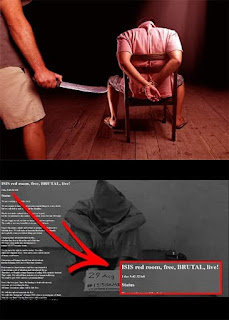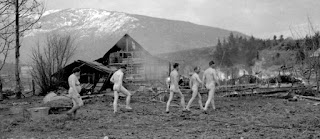U.S. Army Hangman John C. Woods Intentionally Botched Nazi Executions To Ensure Their Agonizing Deaths.
U.S. Army Hangman John C. Woods Intentionally Botched Nazi Executions To Ensure Their Agonizing Deaths.
The Nuremberg executions took place on 16 October 1946, shortly after the conclusion of the Nuremberg trials.
Ten prominent members of the political and military leadership of Nazi Germany were executed by hanging: Hans Frank, Wilhelm Frick, Alfred Jodl, Ernst Kaltenbrunner, Wilhelm Keitel, Joachim von Ribbentrop, Alfred Rosenberg, Fritz Sauckel, Arthur Seyss-Inquart, and Julius Streicher.
Hermann Göring was also scheduled to be hanged on that day, but committed suicide using a potassium cyanide capsule the night before.
Martin Bormann was also sentenced to death in absentia; at the time his whereabouts were unknown, but it is now thought that he committed suicide or was killed by Soviet troops while attempting to escape Berlin on 2 May 1945.
The sentences were carried out in the gymnasium of Nuremberg Prison by the United States Army using the standard drop method instead of long drop.
The executioners were Master Sergeant John C. Woods and his assistant, military policeman Joseph Malta. Woods miscalculated the lengths for the ropes used for the executions, some alleging intentionally, such that some of the men did not die quickly of an intended broken neck but instead strangled to death slowly.
Some reports indicated some executions took from 14 to 28 minutes. The Army denied claims that the drop length was too short or that the condemned died from strangulation instead of a broken neck. Additionally, the trapdoor was too small, such that several of the condemned suffered bleeding head injuries when they hit the sides of the trapdoor while dropping through.
The bodies were rumored to have been taken to Dachau for cremation, but were in fact incinerated in a crematorium in Munich and the ashes scattered over the river Isar.
Kingsbury Smith of the International News Service wrote an eyewitness account of the hangings. His account appeared with photos in newspapers.
READ FULL DETAILED STORY...
U.S. Army Hangman John C. Woods Intentionally Botched Nazi Executions To Ensure Their Agonizing Deaths
John C. Woods lied to the U.S. Army and got them to promote him to the position of the official hangman of the Nazis at Nuremberg — and he made sure they suffered as they died.
There are few tears shed anywhere in the world for the 10 Nazi war criminals hanged by Master Sergeant John C. Woods after their conviction at the Nuremberg Trials following World War II. Of the 10 men he was charged with hanging, quite a few of them weren’t killed by a broken neck, which is how a hanging is supposed to work.
Instead, several of the convicted Nazis died a slow death by strangulation at the end of Woods’ noose. One Nazi, Field Marshall Wilhelm Keital, reportedly took a full 28 agonizing minutes to die. One might say that M/Sgt. Woods was bad at his job, but it’s even more likely that he was deliberately bad at his job, taking a perverse pleasure in the slow torturous deaths of the condemned. For some, this makes his handiwork all that much more fitting for some of the 20th century’s greatest monsters.
“Those Nazis were bad, bad men,” said military historian Col. French MacLean (Ret.). “So what if it took longer for them to die. Maybe they should have thought of that as they were sending people to concentration camps.”
The Early Life And Military Career Of John C. Woods
John Clarence Woods was born on June 5, 1911, in Wichita, Kansas, and was raised by his grandmother following his parents’ divorce when he was only two years old. He made it as far as Wichita High School, but dropped out after attending only two years.
On December 3, 1929, Woods joined the U.S. Navy. However, he went AWOL after a few months. Woods was convicted by a general court-martial and examined by a psychiatric board in April 1930, where it was determined that Woods suffered from Psychopathic Inferiority without Psychosis and was dishonorably discharged:
“This patient, though not intellectually inferior, gives a history of repeatedly running counter to authority both before and since enlistment. Stigmata of degeneration are present and the patient frequently bites his fingernails. He has a benign tumor of the soft palate for which he refuses operation. His commanding officer and division officers state that he shows inaptitude and does not respond to instruction. He is obviously poor service material. This man has had less than five months service. His disability is considered to be an inherent defect for which the service is in no way responsible. [He] is not considered a menace to himself or others.”
Woods returned to Kansas after his discharge, where he worked in a variety of manual labor jobs for the next several years, but he found himself back in the military during World War II. Woods enlisted in the Army in August 1943 and was assigned to Company B, of the 37th Engineer Combat Battalion, 5th Engineer Special Brigade.
MacLean wrote in his book, American Hangman, that Woods probably participated in the D-Day landings at Omaha Beach on June 6, 1944, but Woods doesn’t appear to have any other major combat experience.
John C. Woods Dodges Combat Duty
Prior to the D-Day landing, American military executions in the European Theater of Operations were carried out in England by civilian executioner Thomas Pierrepoint and other British personnel. However, in late 1944, the U.S. Army looked for an enlisted man to take over the execution of American personnel and John C. Woods was one of the applicants for the position.
Asked about his prior experience, Woods lied, telling Army officials that had been the “assistant hangman twice in the State of Texas and twice in the State of Oklahoma.”
Woods’ application was formally accepted in October 1944, and he was attached to the 2913th Disciplinary Training Center as a hangman. The consensus among historians is that Woods lied his way into the job to avoid the possibility of returning to combat duty. Col. MacLean writes:
“He did not get wounded on Omaha Beach, but he saw a bunch of guys get killed. I’m sure he thought, I do not want to go through that experience again… He volunteers to get out of the combat engineers. He is accepted and promoted from private to master sergeant, and his pay goes from $50 to $138 a month.”
John C. Woods The Executioner
Woods served as the primary executioner in the hangings of at least 34 American soldiers in France the remainder of 1944 and 1945. He also assisted in the hanging of at least three other soldiers and Army reports suggest that at least 11 of those executions resulted in bungled hangings.
His first execution in Germany occurred on June 29, 1945, when he hanged three Germans for the murder of an American Lt. Lester E. Reuss. Then, on November 10, 1945, he hanged five Germans involved in the Rüsselsheim massacre of U.S. Airmen of August 26, 1944.
During this period, Wood caught the attention of Herman J. Obermayer, a clerk in the office of the Theater Provost Marshal, who later went on to become a well-known journalist and publisher. Less than impressed by Woods, Obermayer wrote: “John Woods was a short, muscular sort of a man, and I would describe him as kind of the world’s flotsam. He talked the language of the hobos and flotsams and the people who do these kinds of jobs.”
Woods continued serving as the U.S. Army hangman in Germany throughout the Winter and Spring of 1946. His most notable executions during this period were those of 14 men convicted of committing concentration camp atrocities at Dachau over two days, May 28 and 29, 1946.
Woods returned to Landsberg, Germany, for the hanging of German policeman Justus Gerstenberg for the murder of US airman, Sgt. Willard M. Holden. It was there that Woods caught the attention of Lt. Stanley Tilles, who was tasked with organizing the Nuremberg hangings.
The Nuremberg Trials And The Execution Of The Nuremberg 10
Following the atrocities committed by the Nazis during World War II, the Allied powers convened a series of international military tribunals in Nuremberg, Germany, according to the governing international laws of war at the time.
The Nuremberg Trials were most notable for the prosecution of 24 prominent members of Nazi Germany’s political, economic, military, and judicial leadership. The trials’ Tribunal was convened between November 20, 1945, and October 1, 1946, resulting in the conviction of 12 men for war crimes — include Martin Bormann, the head of the Nazi Party Chancellery, who was tried in absentia. The sentence was death by hanging, and it would fall to John C. Woods to carry out the sentence.
Although the Nuremberg Tribunal had sentenced 12 men to hang, one of those, Hermann Göring, committed suicide by ingesting cyanide the night before the execution. As Bormann was still at large — he was believed to have committed suicide in May 1945, but his body was not recovered and identified until 1973 — this left 10 men to be hanged by M/Sgt. John C. Woods.
Woods carried out the death sentences of the Nuremberg 10 in the early morning hours of October 16, 1946, using the standard drop method of hanging instead of the long drop method. The U.S. Army has consistently denied claims that the drop length and other errors caused the condemned men to slowly die from strangulation instead of quickly from a broken neck.
However, evidence and eyewitness accounts remain showing that some of the men died agonizingly slowly. Field Marshal Wilhelm Keitel, Chief of the “High Command of the Armed Forces,” reportedly took 28 minutes to finally choke to death.
Time Magazine published an article on October 28, 1946, detailing some of the horrors of the hangings of the Nuremberg 10. For example, Cecil Catling, a reporter for the London Star “declared that there was not enough room for the men to drop, which would mean that their necks had not been properly broken and that they must have died of slow strangulation.”
Additionally, Time reported that Catling claimed that some of the nooses weren’t correctly tied. As a result, some of the men smashed their heads on the platform as they dropped.
Kingsbury Smith, a correspondent with the International News Service, reported on the execution of Julius Streicher, the publisher of Der Stürmer, a Nazi anti-Semitic newspaper:
“When the rope snapped taut with the body swinging wildly, groans could be heard from within the concealed interior of the scaffold.
“Finally, the hangman, who had descended from the gallows platform, lifted the black canvas curtain and went inside. Something happened that put a stop to the groans and brought the rope to a standstill. After it was over, I was not in the mood to ask what he did, but I assume that he grabbed the swinging body… and pulled down on it. We were all of the opinion that Streicher had strangled.”
After the last man was pronounced dead at 2:57 a.m., Woods was quoted as saying, “Ten men in 103 minutes. That’s fast work,” adding that he “never saw a hanging go off any better.”
In the wake of the hangings, another quote by Woods was published in hundreds of newspapers and magazines worldwide.
“I hanged those ten Nazis … and I am proud of it … I wasn’t nervous. … A fellow can’t afford to have nerves in this business. … I want to put in a good word for those G.I.s who helped me … they all did swell. … I am trying to get [them] a promotion. … The way I look at this hanging job, somebody has to do it. I got into it kind of by accident, years ago in the States …”
In his career as a hangman, Woods is credited with executing 92 men. He continued to serve in the Army after the war with the 7th Engineer Brigade in Eniwetok, Marshall Islands. There, on July 21, 1950, Woods met his own end when he was electrocuted while repairing an engineer lighting set.





.jpeg)
.jpeg)









Comments
Post a Comment